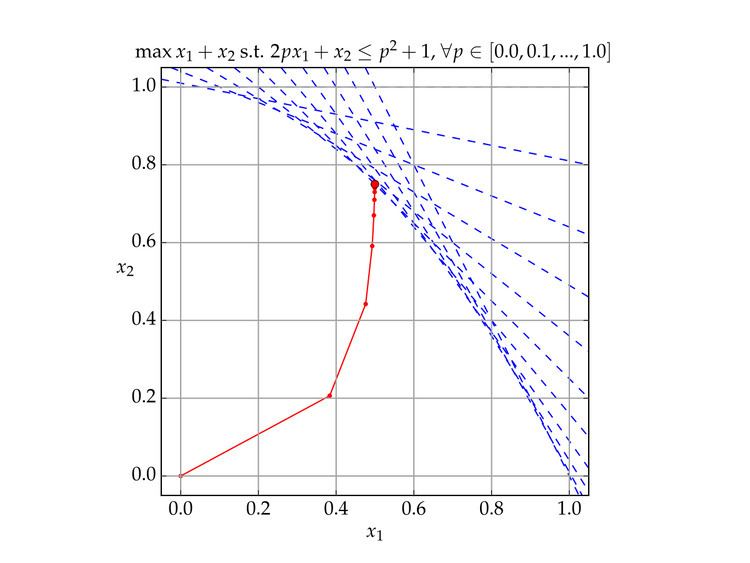 | ||
Interior point methods (also referred to as barrier methods) are a certain class of algorithms that solves linear and nonlinear convex optimization problems.
John von Neumann suggested an interior point method of linear programming which was neither a polynomial time method nor an efficient method in practice. In fact, it turned out to be slower in practice compared to the commonly used simplex method. In 1984, Narendra Karmarkar developed a method for linear programming called Karmarkar's algorithm which runs in probably polynomial time and is also very efficient in practice. It enabled solutions of linear programming problems which were beyond the capabilities of the simplex method. Contrary to the simplex method, it reaches a best solution by traversing the interior of the feasible region. The method can be generalized to convex programming based on a self-concordant barrier function used to encode the convex set.
Any convex optimization problem can be transformed into minimizing (or maximizing) a linear function over a convex set by converting to the epigraph form. The idea of encoding the feasible set using a barrier and designing barrier methods was studied by Anthony V. Fiacco, Garth P. McCormick, and others in the early 1960s. These ideas were mainly developed for general nonlinear programming, but they were later abandoned due to the presence of more competitive methods for this class of problems (e.g. sequential quadratic programming).
Yurii Nesterov and Arkadi Nemirovski came up with a special class of such barriers that can be used to encode any convex set. They guarantee that the number of iterations of the algorithm is bounded by a polynomial in the dimension and accuracy of the solution.
Karmarkar's breakthrough revitalized the study of interior point methods and barrier problems, showing that it was possible to create an algorithm for linear programming characterized by polynomial complexity and, moreover, that was competitive with the simplex method. Already Khachiyan's ellipsoid method was a polynomial time algorithm; however, it was too slow to be of practical interest.
The class of primal-dual path-following interior point methods is considered the most successful. Mehrotra's predictor-corrector algorithm provides the basis for most implementations of this class of methods.
Primal-dual interior point method for nonlinear optimization
The primal-dual method's idea is easy to demonstrate for constrained nonlinear optimization. For simplicity consider the all-inequality version of a nonlinear optimization problem:
minimizeThe logarithmic barrier function associated with (1) is
Here
The barrier function gradient is
where
In addition to the original ("primal") variable
(4) is sometimes called the "perturbed complementarity" condition, for its resemblance to "complementary slackness" in KKT conditions.
We try to find those
Applying (4) to (3) we get an equation for the gradient:
where the matrix
The intuition behind (5) is that the gradient of
Applying Newton's method to (4) and (5) we get an equation for
where
Because of (1), (4) the condition
should be enforced at each step. This can be done by choosing appropriate
